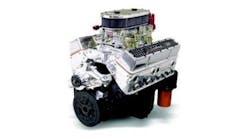The editors reported that the "turbine research people" were saying that two big problems had to be solved before gas turbine engines could be used in mass-produced automobiles — fuel economy and the production of turbine blades in "sufficient quantities at a price that will fit into the mandatory $300 top (price) for the entire gas turbine engine." Research into turbine engines was all the rage in the mid-1950s, following the lead of the aerospace industry where jet turbines completely replaced piston engines. General Motors reported it had solved the fuel economy problem with a "regenerator," a metal mesh drum that rotated the hot exhaust gas through the cooler compressor air. The device captured as much as 80 percent of the exhaust gas, and produced fuel economy "on par with piston driven engines (the turbine used kerosene)." It was installed on the new Whirlfire-504 gas turbine engine in the Firebird II concept car, that included some "imagineering." While they were daydreaming, the GM engineers imagined that future cars would have "electronic brains" to guide them down "dream highways" without the intervention of humans. While turbine engine technology never delivered efficiency and value for cars and has been abandoned by the auto industry, the dream of reducing human efforts in driving has advanced through global positioning technologies such as GM's "OnStar" products.
Latest from Retrospective
Latest from Retrospective
Sept. 19, 2006
Aug. 17, 2006
Aug. 17, 2006
July 5, 2006

